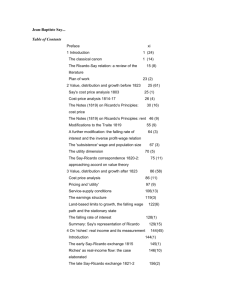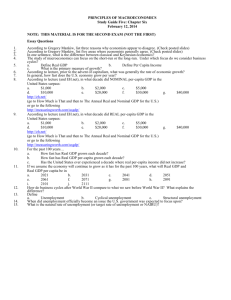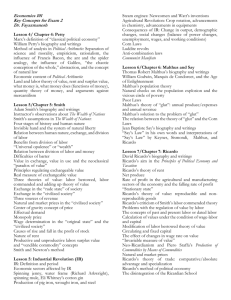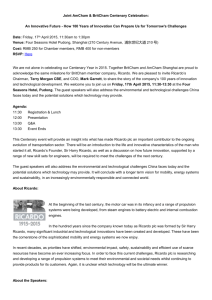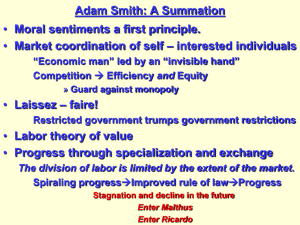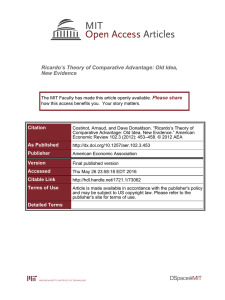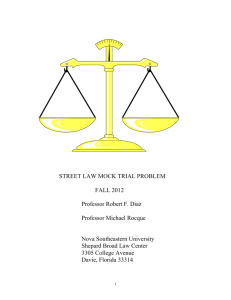Study Guide Eight
advertisement
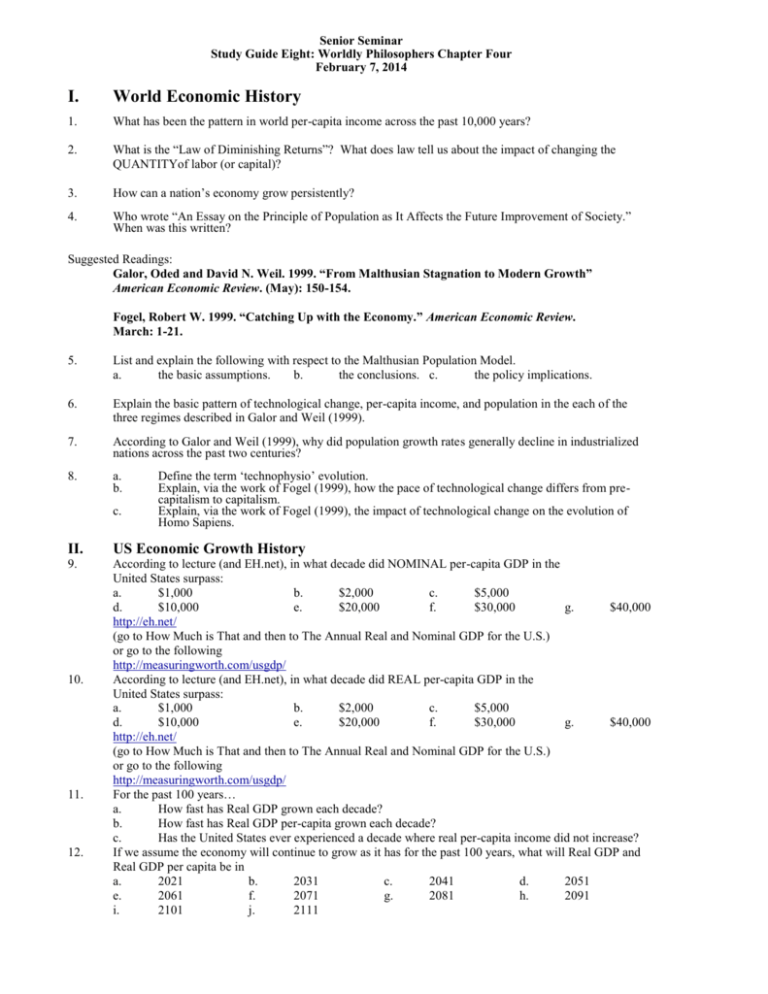
Senior Seminar Study Guide Eight: Worldly Philosophers Chapter Four February 7, 2014 I. World Economic History 1. What has been the pattern in world per-capita income across the past 10,000 years? 2. What is the “Law of Diminishing Returns”? What does law tell us about the impact of changing the QUANTITYof labor (or capital)? 3. How can a nation’s economy grow persistently? 4. Who wrote “An Essay on the Principle of Population as It Affects the Future Improvement of Society.” When was this written? Suggested Readings: Galor, Oded and David N. Weil. 1999. “From Malthusian Stagnation to Modern Growth” American Economic Review. (May): 150-154. Fogel, Robert W. 1999. “Catching Up with the Economy.” American Economic Review. March: 1-21. 5. List and explain the following with respect to the Malthusian Population Model. a. the basic assumptions. b. the conclusions. c. the policy implications. 6. Explain the basic pattern of technological change, per-capita income, and population in the each of the three regimes described in Galor and Weil (1999). 7. According to Galor and Weil (1999), why did population growth rates generally decline in industrialized nations across the past two centuries? 8. a. b. c. Define the term ‘technophysio’ evolution. Explain, via the work of Fogel (1999), how the pace of technological change differs from precapitalism to capitalism. Explain, via the work of Fogel (1999), the impact of technological change on the evolution of Homo Sapiens. II. US Economic Growth History 9. According to lecture (and EH.net), in what decade did NOMINAL per-capita GDP in the United States surpass: a. $1,000 b. $2,000 c. $5,000 d. $10,000 e. $20,000 f. $30,000 g. $40,000 http://eh.net/ (go to How Much is That and then to The Annual Real and Nominal GDP for the U.S.) or go to the following http://measuringworth.com/usgdp/ According to lecture (and EH.net), in what decade did REAL per-capita GDP in the United States surpass: a. $1,000 b. $2,000 c. $5,000 d. $10,000 e. $20,000 f. $30,000 g. $40,000 http://eh.net/ (go to How Much is That and then to The Annual Real and Nominal GDP for the U.S.) or go to the following http://measuringworth.com/usgdp/ For the past 100 years… a. How fast has Real GDP grown each decade? b. How fast has Real GDP per-capita grown each decade? c. Has the United States ever experienced a decade where real per-capita income did not increase? If we assume the economy will continue to grow as it has for the past 100 years, what will Real GDP and Real GDP per capita be in a. 2021 b. 2031 c. 2041 d. 2051 e. 2061 f. 2071 g. 2081 h. 2091 i. 2101 j. 2111 10. 11. 12. III. 1. 2. 3. 4. 5. 6. 7. 8. 9. David Ricardo What argument does Ricardo make in the “High Price of Bullion”? Explain the “Iron Law of Wages”. What happens to wages, profits, and rents as society advances? What is the long-run rate of economic growth in the Ricardian model? Who benefits in the long-run in the Ricardian model? Why were the Corn Laws repealed in 1846? Be sure to note the Reform Act of 1832, the Irish Potato famine, and the work of the cotton industry. According to Anderson and Tollison, were opponents of the Corn Laws truly free trade proponents? Parson Malthus, while pondering over the astounding population growth and “inevitable” lack of resources, came across another problem. “What if products could be made so quickly that there would be a “general glut”—a flood of commodities without buyers—in the market?” David Ricardo responded that it was “logically impossible” due to another certain philosopher. Who was that philosopher and what was his solution to the overflow of commodities? According to lecture, what are the additional benefits of free trade? According to lecture, what is the infant industry argument? Has the United States ever employed the infant industry argument with respect to trade? What is “Ricardian Equivalence”? According to lecture, does the empical evidence support this idea? According to Ricardo, what is the principal problem in Political Economy? Did Robert Lucas agree in 2004? According to lecture, what are some reasons for a change in the focus in Political Economy? From the Book…. Chapter Four: The Gloomy Presentiments of Parson Malthus and David Ricardo 1. a. b. c. According to Gregory King, how many people lived in England and Wales in 1696? How long did King think it would take for the population to double? And how long until it doubled again? How many people live in Great Britain today (you need to look this up)? 2. By the time of Adam Smith, what did Dr. Price think was happening to population? What was the political reaction to this estimate? 3. William Godwin published Political Justice in 1793. How did Godwin characterize the future of crime, government, disease, and marriage? 4. What book did Thomas Malthus publish in 1798? 5. Why did Thomas Carlyle refer to economics as the “dismal science”? 6. a. b. c. 7. According to Ricardo, what was the basic conflict in society? 8. a. b. 9. Who was Maria Edgeworth? 10. Explain the Malthusian Population Doctrine. 11. What broke the Malthusian Trap? 12. a. b. 13. If food prices rise, why do people with very good land benefit the most? What do we call this benefit? 14. In Ricardo’s world, who produces societies’ progress? Who benefits from this progress? 15. a. b. What were the Corn Laws and why were these enacted? In 1813, how did the price of wheat compare to a worker’s wage? Who benefits and who is hurt by a high price of wheat? According to the people at the time, who was not impacted by the price of wheat? What class did Ricardo belong to? What class did he defend? What class did Malthus belong to? What class did he defend? Who are the three actors in Ricardo’s description of the economy? What do these actors get paid? What is a “general glut”? Why did Ricardo think this was “logically impossible”? Be sure to explain Say’s Law.

